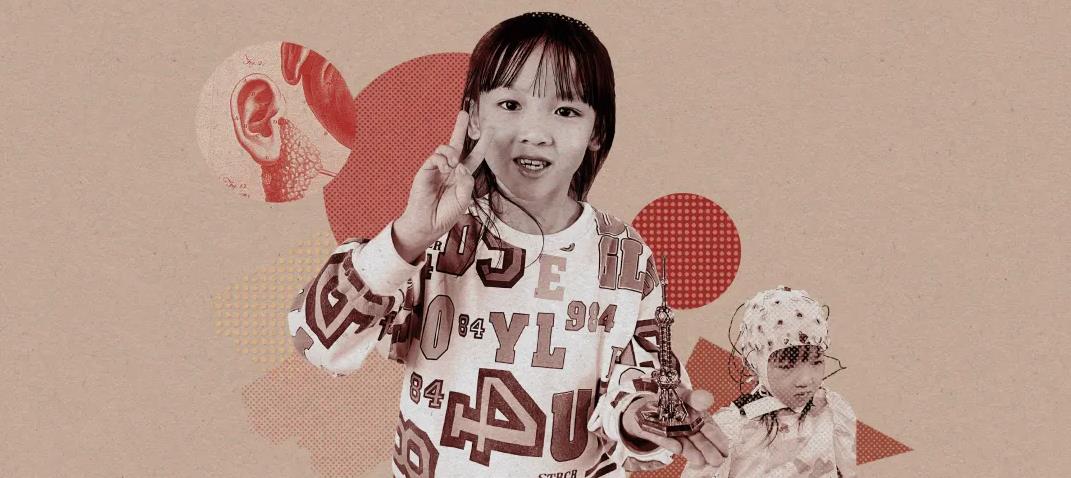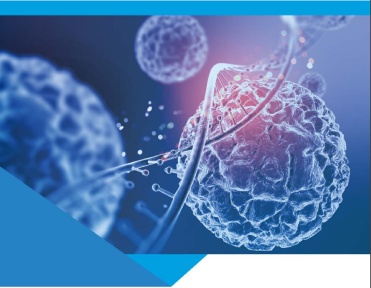
“Clouds, one by one, blossomed in the mountains,” says her mother, Qin Lixue, while covering her mouth so Yiyi can’t read her lips.
“Clouds, one, one, blossomed in big mountains” Yiyi replies.
It’s hard to believe that Yiyi was born entirely deaf.
But this year her family, who live in a high-rise block in the city of Dongguan, enrolled her in a study of a new type of gene therapy. During the procedure, doctors used a virus to add replacement DNA to the cells in Yiyi’s inner ear that pick up vibrations, allowing them to transmit sound to her brain.
In less than a month, her mother says, she was hearing with the treated ear for the first time. Yiyi can’t explain exactly what it’s like in words, but now, at school, she can hear the chime that ends naptime. She used to have to wait for the other kids to tell her.
Yiyi is one of several deaf children who scientists in China say are the first people ever to have their natural hearing pathway restored in a dramatic new demonstration of the possibilities of gene therapy. The feat is even more remarkable because until now, no drug of any kind has ever been able to improve hearing.
“We were careful, and a little bit nervous, because it was the first in the world,” says Yilai Shu, a surgeon and scientist at Fudan University in Shanghai who is leading the experiment. His team began the treatments last December, and before that he spent years developing the techniques involved, testing gene injections in countless mice and guinea pigs. “That was my project: How do we deliver this to the inner ear?” Shu says.
In the US and Europe, gene therapy has been notching successes, including restoring limited vision to people with genetic causes of blindness. Now Shu’s study, in which as many as 10 kids have been enrolled, may be remembered as China’s first domestic gene-therapy breakthrough, as well the most dramatic restoration of a lost sense yet achieved.
“Before the treatment, if you put them in a movie theater with the loudest sound, they wouldn’t hear it,” says Zheng-Yi Chen, an associate professor at Mass Eye and Ear, a Harvard-affiliated hospital in Boston, who helped design and plan the study. “Now they can hear close to normal speech, and one can hear a whisper.”
A huge step
Today, Shu is scheduled to present data on the first five children he treated at a meeting of the European Society for Gene and Cell Therapy in Brussels, Belgium. Four of them gained hearing in the treated ear, but one did not, possibly because of preexisting immunity to the type of virus used to convey new DNA into the body.
“Any hearing improvement I would call a total win, and getting patients to moderate hearing loss is remarkable,” says Lawrence Lustig, a physician at Columbia University who runs studies of hearing treatments. “As a first step, this is huge.”
The new treatment will not help everyone who is deaf. It applies only to one specific cause of deafness at birth: a defect in a gene that produces a protein called otoferlin. The inner ear contains about 16,000 hair cells, so called because they have comblike extensions that vibrate to different frequencies of sound. Without otoferlin, these cells can’t transmit the chemicals that relay information to the brain.
“These patients basically don’t have a signal coming from the hair cells,” says Chen.
Otoferlin gene defects are the cause of around 1% to 3% of cases of inborn deafness, and there are only about 900 new cases a year in China, meaning the condition is rare. But the Chinese success is expected to electrify researchers working on related genetic treatments. “This could be the gateway drug that drives a lot of funds toward other causes of deafness,” says Lustig.
Breaking up a gene
The new treatment is designed to add a working copy of the otoferlin gene. Because of the gene’s large size—it is around 6,000 DNA letters long—it had to be broken into two parts, each packaged separately into millions of copies of a harmless virus. Shu then carefully injects the loaded viruses deep into a fluid-filled chamber in a part of the children’s ears called the cochlea.
Once inside the body, Shu says, the two sections of DNA recombine to make a complete gene able to guide the production of the missing otoferlin protein.
“This technique is not usually done clinically, because the recombination process can be rather inefficient,” says Nicole Paulk, CEO of Siren Biotechnology and an expert on this type of virus, called an adeno-associated virus, or AAV. “This said, if the data they described [is] true, then this is a fantastic result.”
Shu also thinks the treatment can be made more potent. But already, he says, the children’s hearing improved, on average, from not hearing anything under 95 decibels (as loud as a motorcycle) to hearing sounds at 50 to 55 decibels—about the level of a regular conversation.
“They reach maybe 60% to 65% of normal hearing,” says Shu.
Can’t believe it worked
Some of the subjects are just toddlers, who can’t tell doctors anything about what their first experiences of sound are like. But their parents are seeing behavioral changes. According to Shu, one child, who had never spoken, has started to say “baba” and “mama” after the treatment. Shu believes children would ideally be treated at around one year of age, a key moment for speech development.
Yiyi is older, and like several of the children in the trial so far, she had previously received a cochlear implant, an electronic device that uses a receiver and electrodes to stimulate hearing by tapping directly into the main auditory nerve. With the implant in her right ear since she was two, Yiyi had already learned how to speak, although her mother says that when she disconnects it (the receiver and battery are external), “she can’t hear anything at all.”
That changed after the treatment, which was put into her other ear. It was only weeks later that Yiyi could hear naturally from that ear. Her mother notices that she sometimes disconnects her implant while playing with the neighbors.
“When I first heard about the trial, at first I didn’t believe it was real. I asked some audiologists, and they also said it might not be real,” she says. But after she traveled to Shanghai and met Shu and other doctors, she decided to enroll her daughter. “I still can’t quite believe that it worked,” she says.
Chen believes that gene therapy could offer better hearing than what can be achieved with an implant. “Cochlear implants are the most successful neural prosthesis ever developed,” he says, but they have limitations. With an implant, Chen says, “you may hear the music, but the nuance is totally gone—they just hear the beat. We hear wind in the trees and birds singing, but they can’t. So the goal for everyone has been how to reverse hearing loss.”
The decision to target Yiyi’s specific type of deafness was not an accident. Auditory hair cells respond relatively well to gene therapy, easily taking up new DNA. And they don’t grow or get replaced during a person’s life. This is a reason why very loud noises can lead to permanent hearing loss: they can kill the hair cells. But it also means that if a replacement gene is added to the cells, it could remain active for a lifetime, although Shu cautions it’s unknown how long the effect will persist.
Winning the race
The apparent success means the Chinese team has won the first lap in a race involving at least three Western biotechnology companies. Among them is Akouos, which last year was acquired for $500 million by Eli Lilly, and Regeneron’s Decibel Therapeutics. Both have opened clinical trials for gene therapies also targeting the otoferlin gene and Decibel has treated at least one patient.
The Chinese work was sponsored by a small biotech company, Shanghai Refreshgene Therapeutics. That company’s founder, Nova Liu, said treating hearing was part of a strategy to develop gene therapies with reasonable prices. That could be the case with treatments for the eye and ear, since injecting gene therapy into either can require around a thousandth the amount of material needed to administer those treatments as IV infusions. “In China the first element of commercialization is to be affordable,” says Liu.
For Yiyi, hearing better is a revelation, but there are some downsides. The family lives on the 15th floor of an apartment building, but there is a lot of traffic nearby whose rumble reaches their windows. Before the gene therapy, Yiyi would unplug the implant and hear nothing at all during the night.
Now, her mother says, “she’s complaining it’s too noisy.”

Check out our AAV CDMO service to expedite your gene therapy research
PackGene Biotech is a world-leading CRO and CDMO, excelling in AAV vectors, mRNA, plasmid DNA, and lentiviral vector solutions. Our comprehensive offerings span from vector design and construction to AAV, lentivirus, and mRNA services. With a sharp focus on early-stage drug discovery, preclinical development, and cell and gene therapy trials, we deliver cost-effective, dependable, and scalable production solutions. Leveraging our groundbreaking π-alpha 293 AAV high-yield platform, we amplify AAV production by up to 10-fold, yielding up to 1e+17vg per batch to meet diverse commercial and clinical project needs. Moreover, our tailored mRNA and LNP products and services cater to every stage of drug and vaccine development, from research to GMP production, providing a seamless, end-to-end solution.
Related News
Exploring Tau Protein’s Role in Glaucoma: New Insights and Therapeutic Potential
Glaucoma, a chronic neurodegenerative disorder, leads to irreversible vision loss by damaging retinal ganglion cells (RGCs) and the optic nerve, often associated with increased intraocular pressure (IOP). Despite the benefits of IOP-lowering treatments, the underlying...
FDA-mandated CAR-T monitoring period could be halved, say researchers
In patients with diffuse large B-cell non-Hodgkin lymphoma (DLBCL), the two hallmark post-chimeric antigen receptor (CAR)-T therapy toxicities are extremely rare after two weeks, supporting a shorter, more flexible toxicity monitoring period, according to a study...
Ancestral CRISPR-Cas13 Ribonucleases Discovered: Implications for Genome Editing
In a pioneering study published in *Science*, a team of researchers led by Peter H. Yoon and Jennifer A. Doudna from the University of California, Berkeley, has made a remarkable discovery in the realm of CRISPR technology. The team has identified an ancestral clade...
KBI Biopharma Expands Manufacturing Contract with Global Pharmaceutical Company
KBI Biopharma Inc., a JSR Life Sciences company and global cGMP contract development and manufacturing organization (CDMO), has extended and expanded its manufacturing contract with a leading global pharmaceutical company. Originally initiated in 2020, the renewed...
Related Services

